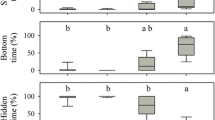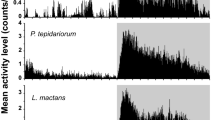Summary
Perch hopping activity and food intake were recorded in starlings in different intensities of continuous illumination (LL), varying from 0.1 to 1000 lux. Circadian rhythmicity in perch hopping disappeared in 10 lux and all higher intensities. In contrast, freerunning circadian rhythms in feeding were always present. In low light intensities, the perch hopping rhythm usually phase leads feeding, increasingly so with shorter circadian period. Locomotor activity may reflect motivational states unrelated to feeding.
Similar content being viewed by others
References
Aschoff J (1960) Exogenous and endogenous components in circadian rhythms. In: Chovnik A (ed) Biological Clocks. Cold Spring Harbor Symp Quant Biol 25:11–28
Aschoff J (1962) Spontane lokomotorische Aktivität. In: Helmcke JG, Lengerken H von, Stark D (eds) Handbuch der Zoologie Bd VIII 11. Teil. Walter de Gruyter, Berlin, pp 1–74
Aschoff J (1964) Die Tagesperiodik licht- und dunkelaktiver Tiere. Rev Suisse Zool 71:528–558
Aschoff J, Figala J, Pöppel E (1973) Circadian rhythms of locomotor activity in the golden hamster (Mesocricetus auratus). Measurements with two different techniques. J Comp Physiol 85:20–28
Aschoff J, Daan S, Honma KI (1982) Zeitgebers, entrainment, and masking: some unsettled questions. In: Aschoff J, Daan S, Groos G (eds) Vertebrate circadian systems. Springer, Berlin Heidelberg New York, pp 13–24
Binkley S (1977) Constant light: effects on the circadian locomotor rhythm in the house sparrow. Physiol Zool 50:170–181
Daan S (1981) Adaptive daily strategies in behavior. In: Aschoff J (ed) Handbook of behavioural neurobiology, vol 4, Biological rhythms. Plenum Press, New York London, pp 275–296
Enright JT (1965) The search for rhythmicity in biological time series. J Theor Biol 8:426–468
Gaston SC, Menaker M (1968) Pineal function: the biological clock in the sparrow? Science 160:1125–1127
Gwinner E (1974) Testosterone induces ‘splitting’ of circadian locomotor activity in birds. Science 185:72–74
Gwinner E (1975) Circadian and circannual rhythms in birds. In: Farner DS, King JR (eds) Biology, vol 5. Academic Press, New York, pp 221–285
Hoffmann K (1960) Versuche zur Analyse der Tagesperiodik. I: Der Einfluß der Lichtintensität. Z Vergl Physiol 43:544–566
Hoffmann K (1971) Splitting of the circadian rhythm as a function of light intensity. In: Menaker M (ed) Biochronometry. Natl Acad Sci Washington DC, pp 134–148
Kacelnik A, Krebs JR (1983) The dawn chorus of the great tit (Parus major): Proximate and ultimate causes. Behaviour 83:287–309
McMillan JP, Keats HC, Menaker M (1975) On the role of eyes and brain photoreceptors in the sparrow: Arrhythmicity in constant light. J Comp Physiol 102:263–268
Pittendrigh CS (1981) Circadian systems: General perspective. In: Aschoff J (ed) Handbook of behavioral neurobiology, vol 4, Biological rhythms. Plenum, New York, pp 57–80
Pittendrigh CS, Daan S (1976) A functional analysis of circadian pacemakers in nocturnal rodents. V. Pacemaker structure: a clock for all seasons. J Comp Physiol 106:333–335
Terman JS, Terman M (1980) Effects of illumination level on the rats rhythmicity of brain self-stimulation behavior. Behav Brain Res 1:507–519
Wever RA (1980) Circadian rhythms of finches under steadily changing light intensity: Are self-sustaining circadian rhythms self-excitatory? J Comp Physiol 140:113–119
Author information
Authors and Affiliations
Rights and permissions
About this article
Cite this article
Gänshirt, G., Daan, S. & Gerkema, M.P. Arrhythmic perch hopping and rhythmic feeding of starlings in constant light: Separate circadian oscillators?. J. Comp. Physiol. 154, 669–674 (1984). https://doi.org/10.1007/BF01350220
Accepted:
Issue Date:
DOI: https://doi.org/10.1007/BF01350220




